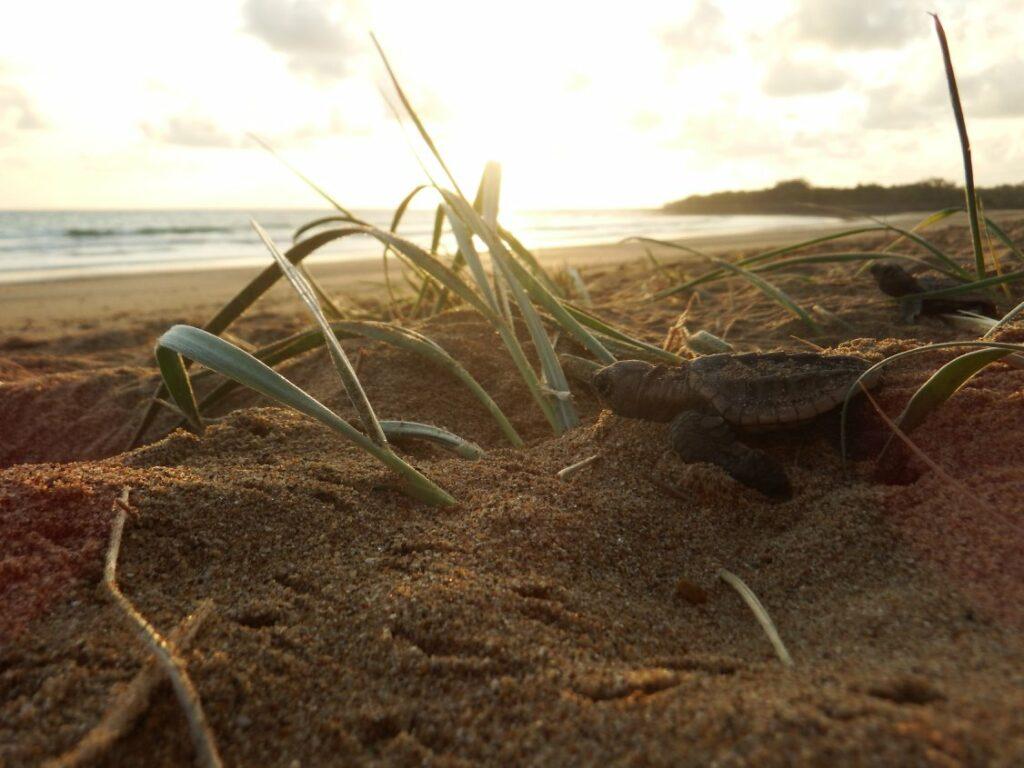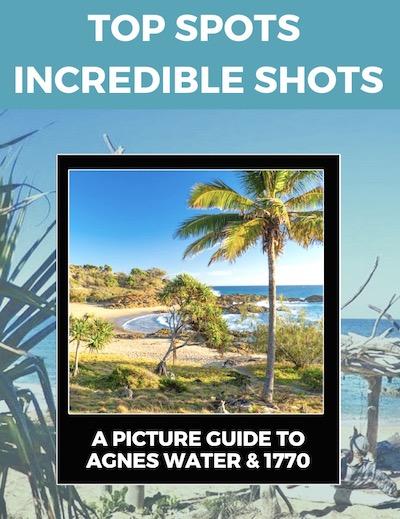Introduction
The locals of Agnes Water and 1770 are no strangers to sea turtles. Our waterways grow meadows of seagrass for green turtles, our beaches host nurseries to Greens, Loggerheads and Flatbacks, and our marina opens a gateway to the Southern Great Barrier Reef where we can spot all three and also the critically endangered Hawksbill Turtle.
Best Way to Encounter Turtles
Hands down one of the greatest turtle experiences can be found at Mon Repo. The Mon Repos Turtle Centre is dedicated to marine turtle research, protection and education. It is 1.5hrs from Agnes Water and operated by Queensland Parks and Wildlife. Their expertly controlled environment allows visitors a close up immersive experience with nesting endangered Loggerhead Turtles and their hatchlings.


Our other favourite turtle encounter option is visiting Lady Musgrave Island with 1770 Reef or 1770 Creek to Reef and swimming with them. Lady Musgrave Island is uniquely surrounded by a lagoon reef and inside are what we call turtle cleaning stations. These are coral bommies that are favoured by turtles (mainly Green and Hawksbill) as well as cleaner fish. The turtles pull up to these stations under the water to get their shells cleaned and parasites removed. We can almost guarantee turtle sightings while here.
Nesting at Agnes Water
From November through to April all of the beaches in and around Agnes Water and 1770 are turtle nesting areas. Three types of turtles nest here – Loggerhead, Flatback and Green. While the vast majority are Loggerheads. Will you see these turtles while visiting? Honestly, probably not. Nesting numbers have greatly declined since the 80s due to human interference, feral pest predation, domestic animals, commercial fishing and climate conditions.
Another reason why you won’t see them is because they are very shy, will generally only nest in the middle of the night, are very picky about where they lay, will be deterred by light and movement. However, if you are lucky and walking the beach in the mornings you may come across fresh tracks of one of these night time ninjas.
Behind the Scenes
What most people are unaware of during the nesting season, is our local turtle research volunteers. Every beach along our coast has allocated volunteers, that will walk the beaches daily and record each and every nesting event. Beaches south of Chinamans Beach, not only record nesting events, but place markers near their location which also helps record hatching successes. If you are interested in getting involved as a research volunteer you can contact the Discovery Coast Environmental Group.
All data from this research is entered into the Queensland Turtle Conservation Project Database created by the Department of Environment and Science.
You Can Help
- Leave the beach cleaner than when you found it.
- Keep dogs on leash. Please be aware that some beaches will be closed entirely to dogs.
- Don’t light fires.
- Report turtle sightings 0427 358 201.
- Fill in beach holes.
- Turn off lights.
- Report fox sightings — > Here
What To Do If You See a Turtle
Sometimes you just get lucky. You can be in the right place at the right time and have a once in a lifetime encounter with a turtle nesting. Lucky you! Here’s what to do.
- Stop and stand still.
- If at night, extinguish all lights.
- Slowly lower yourself to a seated position on the ground.
- Avoid any sudden movements and do not approach.
- Report the turtle by calling 0427 358 201.
- Then sit back, relax and observe the magic.
- You can assess what the turtle is doing.
- If she is moving up the beach, she is looking for a safe place to lay. Do not approach, you can spook her and she can return to the sea without laying.
- If she is in the dune throwing sand around, then she is digging a nest. Do not approach you can spook her and she can return to the sea without laying.
- If she is in the dune and not moving, she could be laying eggs. Still do not approach her, but movement is less likely to interfere with the nesting process so if you need to move around slightly, it is fine at this point.
- If she is moving down the beach to the water, she is returning to sea. Keep at least 10m away and avoid standing in front of her.
Keep in mind that serious fines apply to any unauthorised interference with nesting turtles.
Turtle Strandings and Rescues
If you have encountered a turtle below the hightide mark that is not moving. Wait ten minutes and observe just incase it’s a nesting female taking a breather. If after 10 minutes there is still no movement, you may have come across an unwell turtle. Sadly the amount of sick and injured turtles has been increasing. If you should come across a sick, injured or deceased turtle please call our local strandings coordinator 0439 289 633 or Quoin Island 0408 431 304.
All turtle patients from Agnes Water and 1770 get sent to Quoin Island Turtle Rehabilitation Centre in Gladstone for treatment. Not all of them make it, but there are good stories like this one below from 1770 LARC! Tours.

